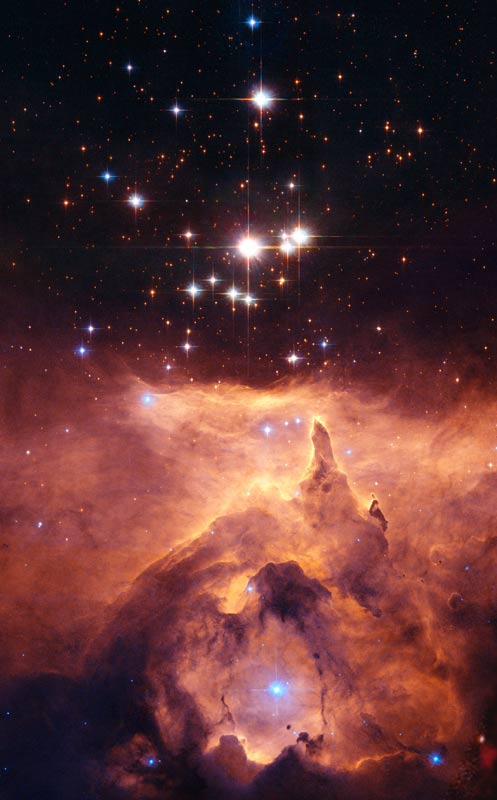Monster Star Cut Down to Size

A monster star thought to be among the mostmassive in our Milky Way galaxy isactually slimmer than expected because it's actually a pair of twins,astronomers announced today.
Researchersonce believed the star--known as Pismis 24-1--loomed large with a mass between200 and 300 times that of the Sun. Butmore accurate measurements by the Hubble Space Telescope foundnot one, but two stars in Pismis 24-1's location, effectively cutting the estimatedweight in half to about 100 solar masses.
The stellarfind is part of a study to determine the upper mass limit for stars.
Pismis 24-1sits in star cluster at the core of the emissionnebula NGC 6357 some 8,000 light-years from Earth towards the constellationSagittarius [image].Young hot stars spew intense ultraviolet radiation into the nebula, heating upthe surrounding interstellar gas to create a sort of local bubble, Hubbleresearchers said in a statement.
Astronomer Jes?s Ma?z Apell?niz, of Spain's Instituto de Astrof?sicade Andaluc?a, led the study to weigh Pismis 24-1. His team also managed togauge the mass of a third nearby star, dubbed Pismis 24-1, and pegged thatobject at about 100 solar masses.
Theresearch, which relied on images taken by Hubble's Advanced Camera forSurveys, was presented this month at the Massive Stars Workshop inArgentina.
The trio ofheavyweight stars within the Pismis 24 system is a rare find for such a smallstellar cluster, Hubble researchers said. For every discovery of a 65-solarmass star, some 18,000 Sun-mass stars are formed, they added.
Breaking space news, the latest updates on rocket launches, skywatching events and more!
Thelifecycle of a 65-solar mass star ends after just three million years, though aSun-mass star can burn for more than 3,000 times that. Our own Sun isconsidered middle-aged at 4.6 billion years old.
It's possiblethat Pismis 24-1 may include a third star based on some ground observations,Hubble researchers added. If true, each of the three stars would average about70 stellar masses, but remain on the Top 25 roster of the Milky Way's mostmassive stars.
Join our Space Forums to keep talking space on the latest missions, night sky and more! And if you have a news tip, correction or comment, let us know at: community@space.com.

Tariq is the award-winning Editor-in-Chief of Space.com and joined the team in 2001. He covers human spaceflight, as well as skywatching and entertainment. He became Space.com's Editor-in-Chief in 2019. Before joining Space.com, Tariq was a staff reporter for The Los Angeles Times covering education and city beats in La Habra, Fullerton and Huntington Beach. He's a recipient of the 2022 Harry Kolcum Award for excellence in space reporting and the 2025 Space Pioneer Award from the National Space Society. He is an Eagle Scout and Space Camp alum with journalism degrees from the USC and NYU. You can find Tariq at Space.com and as the co-host to the This Week In Space podcast on the TWiT network. To see his latest project, you can follow Tariq on Twitter @tariqjmalik.
